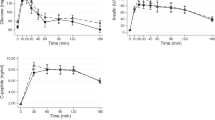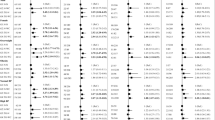Abstract
AIMS: Increased fasting and postprandial triglyceridemia is one of the cardiovascular risk factors for patients with insulin resistance. Since triglyceride (TG) metabolism largely depends on gender, we have investigated diurnal TG changes in patients with and without overweight, focusing on gender differences.
METHODS: Twenty-two males and 22 females with overweight (mean body mass index (BMI) 28.0±2.3 kg/m2) measured capillary TG concentrations at six fixed time points on three different days. Diurnal TG profiles were calculated as area under the capillary TG curves (TGc-AUCs). The control group consisted of 24 males and 21 females who were not overweight (mean BMI 22.4±1.5 kg/m2). Biochemical and anthropometric parameters associated with insulin resistance were measured.
RESULTS: Lean males and lean females had comparable fasting insulin levels (6.9±2.6 and 8.1±4.7 mU/l, respectively), but females had a more favorable fasting lipoprotein profile when compared to males. Diurnal TG profiles were lower in lean females than in lean males (16.9±4.3 vs 20.3±5.7 mMh, respectively, P<0.05). Overweight males and females had comparable fasting insulin levels (10.3±3.4 and 12.1±4.9 mU/l, respectively), which were higher than in lean subjects. Overweight females also had a more favorable fasting lipoprotein profile compared to overweight males. Diurnal TG profiles were similar in overweight females and overweight males (31.1±15.6 and 32.9±13.2 mMh, respectively). Stepwise multiple regression analysis showed that in both males and females, waist circumference was the strongest determinant of diurnal TG profiles when fasting TG concentrations were excluded from the model (R2=0.49 for males and R2=0.33 for females). These results suggest that overweight resulted in a ‘male diurnal TG profile’ in females due to abdominal fat accumulation.
CONCLUSION: Insulin resistance in overweight subjects partly mitigates the gender differences of fasting and postprandial TG metabolism. The significant positive association between diurnal triglyceridemia and waist circumference supports the view that especially abdominal fat associated with insulin resistance enhances postprandial lipemia.
This is a preview of subscription content, access via your institution
Access options
Subscribe to this journal
Receive 12 print issues and online access
$259.00 per year
only $21.58 per issue
Buy this article
- Purchase on Springer Link
- Instant access to full article PDF
Prices may be subject to local taxes which are calculated during checkout



Similar content being viewed by others
References
Austin MA, Hokanson JE, Edwards KL . Hypertriglyceridemia as a cardiovascular risk factor Am J Cardiol 1998 81: 7B–12B.
Stavenow L, Kjellström T . Influence of serum triglyceride levels on the risk for myocardial infarction in 12510 middle aged males: interaction with serum cholesterol Atherosclerosis 1999 147: 243–247.
Miller M, Seidler A, Moalemi A, Pearson TA . Normal triglyceride levels and coronary artery disease events: the Baltimore coronary observational long-term study J Am Coll Cardiology 1998 31: 1252–1257.
Karpe F, Steiner G, Uffelman K, Olivecrona T, Hamsten A . Postprandial lipoproteins and progression of atherosclerosis Atherosclerosis 1994 106: 83–97.
Patsch JR, Miesenböck G, Hopferwieser T, Mühlberger V, Knapp E, Kay Dunn J, Gotto AM, Patsch W . Relation of triglyceride metabolism and coronary artery disease Arterioscler Thromb 1992 12: 1336–1345.
Castro Cabezas M, Bruin TWA de, Kock LAW, Linde-Sibenius Trip M, Jansen H, Erkelens DW . Simvastatin improves chylomicron remnant removal in familial combined hyperlipidemia without changing chylomicron conversion Metabolism 1993 42: 497–503.
Björkegren J, Boquist S, Samnegard A, Lundman P, Tornvall P, Ericsson CG, Hamsten A . Accumulation of apolipoprotein C-I-rich and cholesterol-rich VLDL remnants during exaggerated postprandial triglyceridemia in normolipidemic patients with coronary artery disease Circulation 2000 101: 227–230.
Groot PHE, Stiphout WAHJ van, Krauss XH, Jansen H, Tol A van, Ramshorst E van, Chin-On S, Hofman A, Creswell SR, Havekes L . Postprandial lipoprotein metabolism in normolipidemic men with and without coronary artery disease Arterioscler Thromb 1991 11: 653–662.
Meyer E, Westerveld HT, de Ruyter-Heijstek FC, van Greevenbroek MMJ, Rienks R, Rijn HJM van, Erkelens DW, de Bruin TWA . Abnormal postprandial apolipoprotein B-48 and triglyceride responses in normolipidemic women with greater than 70% stenotic coronary artery disease: a case control study Atherosclerosis 1996 124: 221–235.
Weintraub MS, Grosskopf I, Rassin T, Miller H, Charach G, Rotmensch HH, Liron M, Rubinstein A, Iaina A . Clearance of chylomicron remnants in normolipidaemic patients with coronary artery disease: case control study over three years Br Med J 1996 312: 935–939.
Lewis GF, O'Meara NM, Soltys PA, Blackman JD, Iverius PH, Druetzler AF, Getz GS, Polonsky KS . Postprandial lipoprotein metabolism in normal and obese subjects: comparison after the vitamin A fat-loading test J Clin Endocrinol Metab 1990 71: 1041–1051.
Couillard C, Bergeron N, Prud'homme D, Bergeron J, Tremblay A, Bouchard C, Mauriège P, Després JP . Gender differences in postprandial lipemia. Importance of visceral adipose tissue accumulation Arterioscler Thromb Vasc Biol 1999 19: 2448–2455.
Mero N, Malmstrom R, Steiner G, Taskinen MR, Syvanne M . Postprandial metabolism of apolipoprotein B48 and B100 containing particles in type 2 diabetes mellitus: relations to angiographically verified severity of coronary artery disease Artherosclerosis 2000 150: 167–177.
Howard BV . Insulin resistance and lipid metabolism Am J Cardiol 1999 84: 28J–32J.
Couillard C, Bergeron N, Prud'homme D, Bergeron J, Tremblay A, Bouchard C, Mauriège P, Després JP . Postprandial triglyceride response in visceral obesity in men Diabetes 1998 47: 953–960.
Guerci B, Vergès B, Durlach V, Hadjadj S, Drouin P, Paul J-L . Relationship between altered postprandial lipemia and insulin resistance in normolipidemic and normoglucose tolerant obese people Int J Obes Relat Metab Disord 2000 24: 468–478.
Vansant G, Mertens A, Muls E . Determinants of postprandial lipemia in obese women Int J Obes Relat Metab Disord 1999 23 (Suppl 1): S12–S21.
Castro Cabezas M, Halkes CJM, Meijssen S, Oostrom AJHMM, van Erkelens DW . Diurnal triglyceride profiles: a novel approach to study triglyceride changes Atherosclerosis 2001 155: 219–228.
Oostrom AJHHM van, Castro Cabezas M, Ribalta J, Twickler ThB, Remijnse TA, Erkelens DW . Diurnal triglyceride profiles in healthy normolipidemic male subjects are associated to insulin sensitivity, body composition and diet Eur J Clin Invest 2000 30: 964–971.
Report of the Expert Committee on the Diagnosis and Classification of Diabetes Mellitus Diabetes Care 1997 20: 1183–1197.
Moses RG, Calvert D, Storlien LH . Evaluation of the Accutrend GCT with respect to triglyceride monitoring Diabetes Care 1996 19: 1305–1306.
Luley C, Ronquist G, Reuter W, Paal V, Gotschling HD, Westphal S, King GL, Bakker SJL, Heine RJ, Hattemer A . Point-of-care testing of triglycerides: evaluation of the accutrend triglycerides system Clin Chem 2000 46: 287–291.
Breedveld J, Hammink J, van Oosten HM . The Dutch food composition table Netherlands Centre for Nutrition Education: The Hague 1998
Matthews DR, Hosker JP, Rudenski AS, Naylor BA, Treacher DF, Turner RC . Homeostasis model assessment: insulin resistance and β-cell function from fasting plasma glucose and insulin concentrations in man Diabetologia 1985 28: 412–419.
Brenner H, Heiss G . The intraindividual variability of fasting triglyceride-a challenge for further standardization Eur Heart J 1990 11: 1054–1058.
Hulse M, Gershberg H . Variability in blood cholesterol, triglycerides, free fatty acids, glucose and body weight in maturity-onset diabetics Am J Med Sci 1969 258: 114–120.
Stampfer MJ, Krauss RM, Ma J, Blanche P, Holl LG, Sacks FM, Hennekens CH . A prospective study of triglyceride level, low-density lipoprotein particle diameter, and risk of myocardial infarction JAMA 1996 276: 882–888.
Boquist S, Ruotolo G, Tang R, Björkegren J, Bond MG, Faire U, de Karpe F, Hamsten A . Alimentary lipemia, postprandial triglyceride-rich lipoproteins, and common carotid intima-media thickness in healthy, middle-aged men Circulation 2000 100: 723–728.
Goris AHC, Westerterp-Plantenga MS, Westerterp KR . Undereating and enderrecording of habitual food intake in obese men: selective underreporting of fat intake Am J Clin Nutr 2000 71: 130–134.
Klesges RC, Eck LH, Ray JW . Who underreports dietary intake in a dietary recall? Evidence from the second National Health and Nutrition Survey J Consult Clin Psychol 1995 63: 438–444.
Macdiarmid J, Blundell JE . Assessing dietary intake: who, what and why of under-reporting Nutr Res Rev 1998 11: 231–235.
St-Amand J, Després J-P, Lemieux S, Lamarche B, Moorjani S, Prud'homme D, Bouchard C, Lupien PJ . Does lipoprotein lipase activity explain the protective lipoprotein profile of premenopausal women? Metabolism 1991 44: 491–498.
Saleh J, Sniderman AD, Cianflone K . Regulation of plasma fatty acid metabolism Clin Chim Acta 1999 286: 163–180.
Peterson J, Bihain BE, Bengtsson-Olivecrona G, Deckelbaum RJ, Carpentier YA, Olivecrona T . Fatty acid control of lipoprotein lipase: a link between energy metabolism and lipid transport Proc Natl Acad Sci USA 1990 87: 909–913.
Karpe F, Olivecrona T, Walldius G, Hamsten A . Lipoprotein lipase in plasma after an oral fat load: relation to free fatty acids J Lipid Res 1992 33: 975–984.
Bjorntop P . The regulation of adipose tissue distribution in humans Int J Obes Relat Metab Disord 1996 20: 291–302.
Siiteri PK . Adipose tissue as a source of hormones Am J Clin Nutr 1987 45: 277–282.
Castro Cabezas M, de Bruin TWA, de Valk HW, Shoulders CC, Jansen H, Erkelens DW . Impaired fatty acid metabolism in familial combined hyperlipidemia. A mechanism associating hepatic apolipoprotein B overproduction and insulin resistance J Clin Invest 1993 92: 160–168.
Wiesenthal SR, Sandhu H, McCall RH, Tchipashvili V, Yoshii H, Polonsky K, Shi ZQ, Mari A, Giacca A . Free fatty acids impair hepatic insulin extraction in vivo Diabetes 1999 48: 766–774.
Riemens SC, Sluiter WJ, Dullaart RPF . Enhanced escape of non-esterified fatty acids from tissue uptake: its role in impaired insulin-induced lowering of total rate of appearance in obesity and type II diabetes mellitus Diabetologia 2000 43: 416–426.
Laws A, Hoen HM, Selby JV, Saad MF, Haffner SM, Howard BV . Differences in insulin suppression of free fatty acid levels by gender and glucose tolerance status Arterioscler Thromb Vasc Biol 1997 17: 64–71.
Georgopoulos A, Rosengard AM . Abnormalities in the metabolism of postprandial and fasting triglyceride-rich lipoprotein subfractions in normal and insulin-dependent diabetic subjects: effects of sex Metabolism 1989 38: 781–789.
Cohn JS, McNamara J, Cohn SD, Ordovas JM Schaefer EJ . Postprandial plasma lipoprotein changes in human subjects of different ages J Lipid Res 1988 29: 469–479.
Després JP . The insulin resistance–dyslipidemic syndrome of visceral obesity: effect on patients' risk Obes Res 1998 6 (Suppl 1): 8S–17S.
Author information
Authors and Affiliations
Corresponding author
Rights and permissions
About this article
Cite this article
Halkes, C., Castro Cabezas, M., van Wijk, J. et al. Gender differences in diurnal triglyceridemia in lean and overweight subjects. Int J Obes 25, 1767–1774 (2001). https://doi.org/10.1038/sj.ijo.0801831
Received:
Published:
Issue Date:
DOI: https://doi.org/10.1038/sj.ijo.0801831
Keywords
This article is cited by
-
Postprandial triglyceride response in normolipidemic, hyperlipidemic and obese subjects – the influence of polydextrose, a non-digestible carbohydrate
Nutrition Journal (2015)
-
Chylomicrons: A Key Biomarker and Risk Factor for Cardiovascular Disease and for the Understanding of Obesity
Current Cardiovascular Risk Reports (2012)
-
Introduction to the DISRUPT postprandial database: subjects, studies and methodologies
Genes & Nutrition (2010)
-
Effects of continuous versus accumulated activity patterns on postprandial triacylglycerol concentrations in obese men
International Journal of Obesity (2008)



